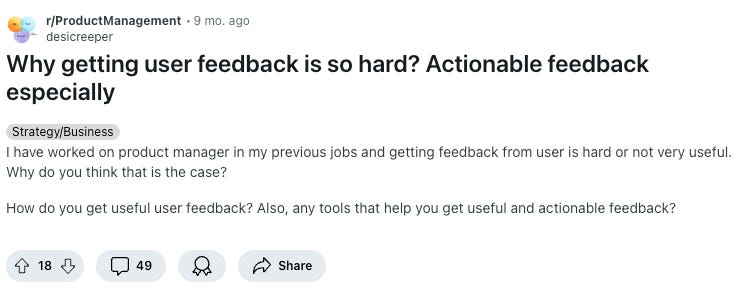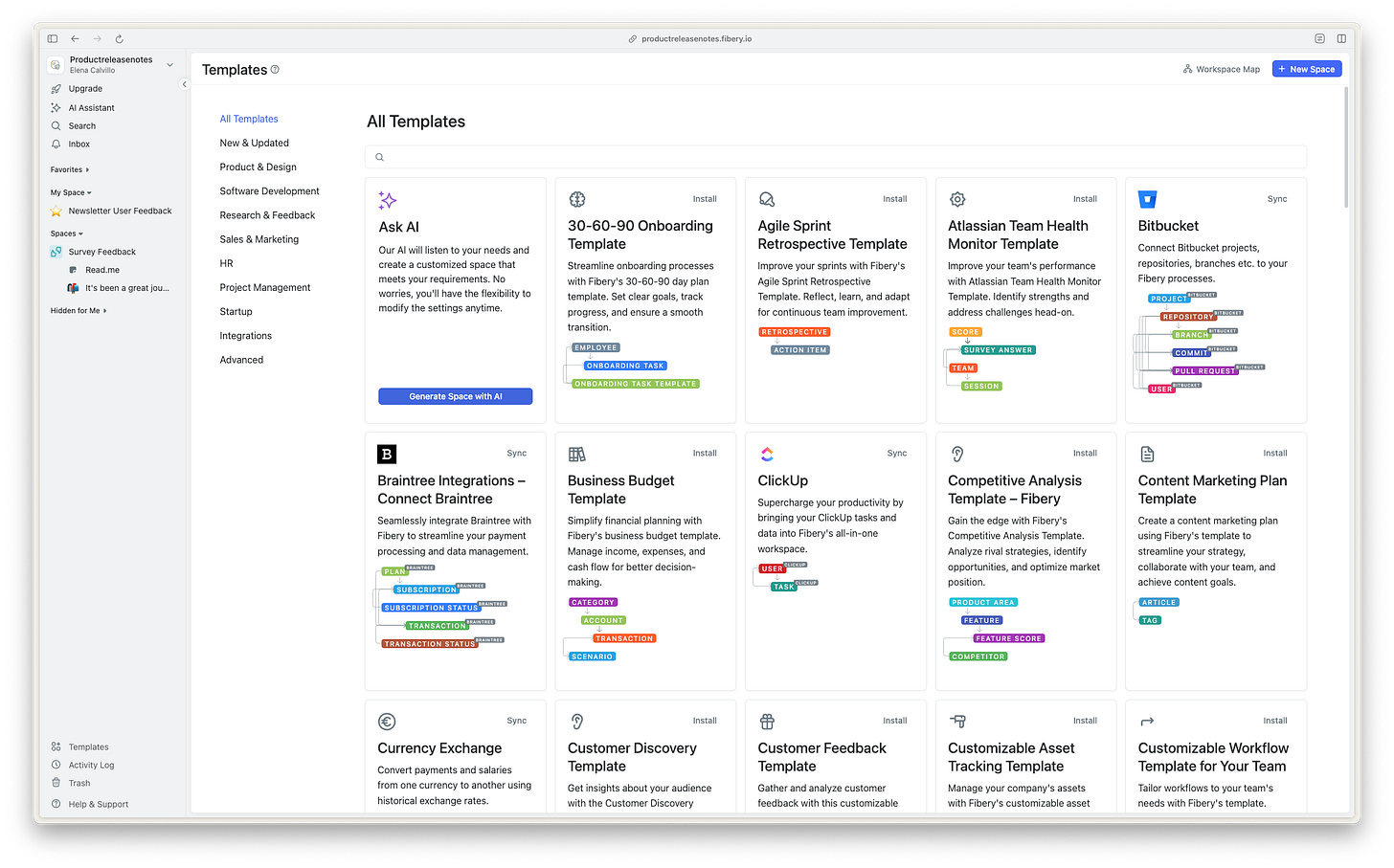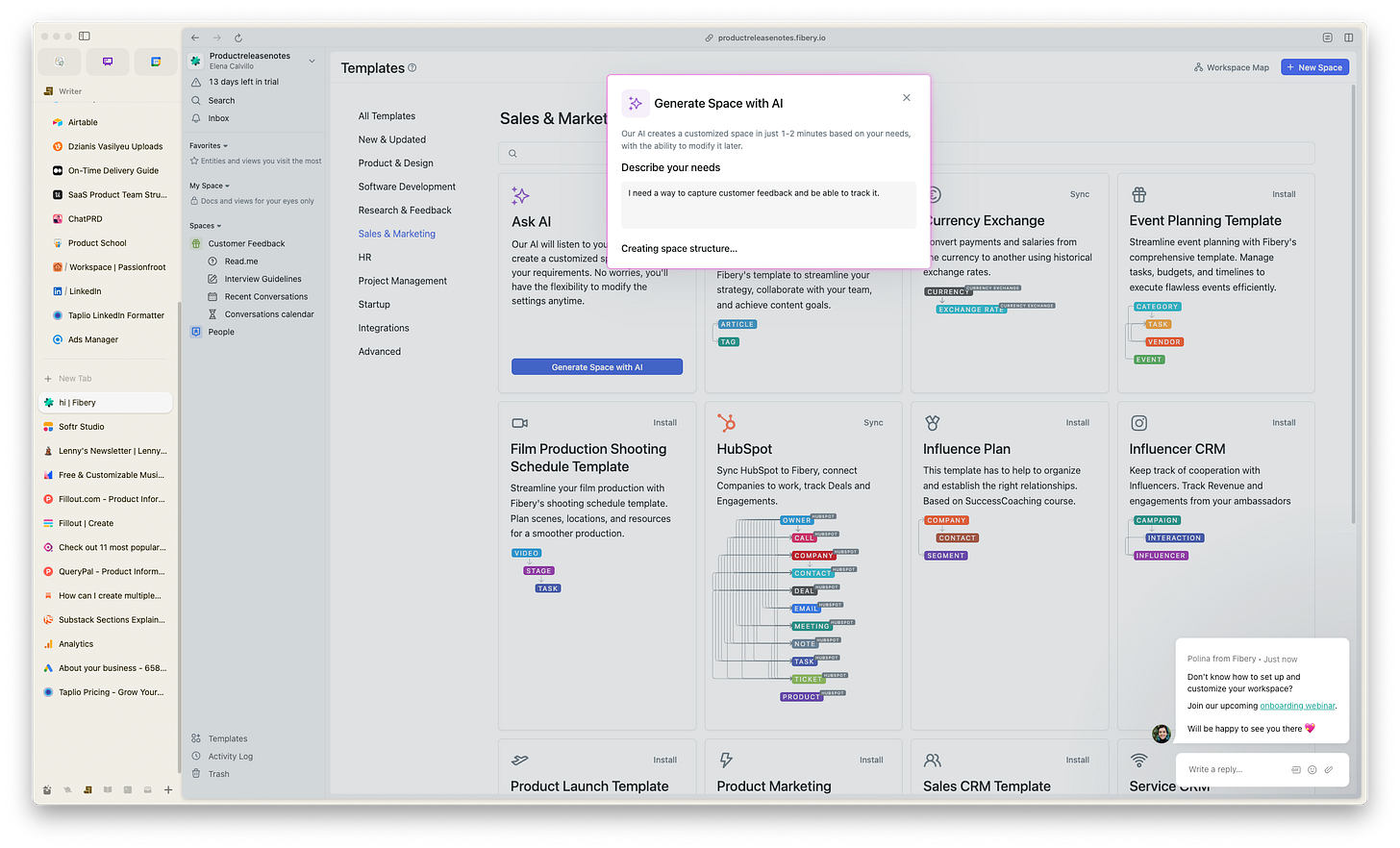How To Turn Customer Feedback Into Actionable Product Strategy
How I treated my newsletter as a product and identified actionable feedback while maintaining an almost endless supply of ideas for content creation.
This post is sponsored by Fibery.io
Streamline your workflow from feedback to feature release, craft detailed specifications and create actionable roadmaps, all in one place!
In the product world, the voice of the customer acts as a guiding star that lights the way to innovation and user satisfaction. However, capturing this slippery voice can often feel like trying to complete a stage in Mario 3D World: You're dodging obstacles, defeating enemies, jumping from platform to platform, and trying to collect as many stars as possible before time runs out.
Part of this challenge is that, most of the times, users are not sufficiently motivated to give their opinion. They may feel that their input will not make a difference, or they may not have enough time or interest. Let’s be realistic, when was the last time you answered a survey?
On top of that, there's the issue of biased feedback, which can incline the data towards the extremes of user satisfaction 🤩 or dissatisfaction 😤. Adding to these challenges are:
🍪 Misaligned incentives,
📉 limited resources for thorough analysis,
☯️ and the delicate balance of aligning feedback with the product’s vision.
Getting user feedback is hard!
Just check on other product management communities and you’ll see, here’s one from Reddit:
Despite these challenges, the commitment to understanding and leveraging user feedback remains as a vital quest for any product. You will not just find barriers but opportunities for growth, connection, and for creating products that resonate deeply with the people they're designed to serve.
In this in-depth guide, I will walk you through my process of how I treated my newsletter as a product and identified actionable feedback while maintaining an almost endless supply of ideas for content creation.
Here’s what I discovered.👇
The Problem Of Forcing User Feedback
If you browse through my old posts, you will see that they are not very good. My first articles covered the typical topics like "what is product management" or "the difference between product owner and product manager". They were forgettable and very repetitive.
With time and consistency, my content started to improve. But I still struggled with ideas and what to write about from once in a while. So I said to myself: "I think it's time to implement a feedback machine".
I started creating visually appealing surveys, but none of them worked. I imagined that many readers would participate in them, but I only got 1-3 responses at most. 😱 Even using Substack’s chat and surveys did not help.
What Was I Doing Wrong? 🥲
Naively, I thought that if my readers liked the content, they would surely have time to answer very long questions and spend 20 minutes or more of their time on them. Of course, reducing the number of questions didn't work either.
Well, the truth is that I wasn't thinking about my audience at all. I was not listening. 🙉
Unconsciously, my newsletter was facing these product challenges:
🕒 Low response rates may be due to lack of motivation, time, or interest.
🔄 Bias in responses can skew feedback towards extremes of satisfaction or frustration.
🧩 Translating qualitative data into actionable insights can be complex.
🔊 Noise in data from a variety of feedback can make prioritizing insights difficult.
💬 Users may struggle to clearly articulate their needs, making it challenging for product managers.
🎯 Wrong incentives for feedback may not align well with feedback mechanisms in place.
🛠️ Product teams may lack resources or tools to effectively analyze feedback.
⚖️ Deciding which feedback to act on can be challenging, especially if it conflicts with product vision.
⏳ Timing of feedback may be difficult if changes are costly post-release.
🔄 Closing the feedback loop to show value to users can be complex and resource-intensive.
Recognizing these challenges is the first step to overcoming them. I started treating my newsletter as a product to make it more strategic and focused on capturing and effectively utilizing user feedback. I could finally breathe, now I had to find a solution! 🔍
Implementing a Feedback Machine with Fibery.io
The first thing I needed to address was changing entirely the approach to getting user feedback. Putting on my audience shoes was something I could relate to.
👩🏻💼 I'm a newsletter reader too, I follow so many great writers that I don't have time to read all your content every day, as much as I would love to. How many times have I missed their posts, an opportunity to give feedback or respond to a survey?
If this is happening to newsletters that have thousands of subscribers. There is a higher probability that this is also happening to mine.
Incentives Over Favors
With this lesson learned, I created a different post. I posted my excitement for a big milestone and shared a brief dynamic. Most of my readers are free subscribers who joined at a certain time and didn't get a chance to participate in previous content that was worthwhile for them.
So I came up with gifting a PDF version of that archived article. They were able to choose any article they felt curiosity about or was meaningful to them.
In that same post, I mentioned at the end that if it wasn't too much to ask, there was a very (very this time) short feedback form so you could leave your opinion in 1 minute.
This is how the improved flow looks like 👇
Compared to the other traditional survey method, this time reader participation increased exponentially. I started receiving messages from Substack, many email responses and others filled out the questionnaire with thoughtful ideas.
Of course, all that feedback is useless if you don't use it to your advantage. You see, as in any product, feedback from your users is not only a way to understand if you are going in the right direction, but a way to identify and solve other kinds of problems for your users. This can be turned into opportunities that your product can start to offer.
This is where Fibery.io comes in place with it’s great feedback management system. 📬
Looking for a Great Feedback Management Tool
Choosing the right set of tools to build a user feedback system is difficult. One of my main goals for this, was to build something fast without the burden of creating something from scratch. Many ideas came to mind, but most of them required a LOT of my time to set everything up correctly. The list of requirements looked like:
🛠️ Choose a great survey tool, easy to set up
📤 Create a form that I can easily share with my readers. No need to be fully customizable.
🤔 Can the tool do sentiment analysis?
🔁 Transform the feedback into actionable items
🗺️ Craft a roadmap and prioritize content
🔍 Determine the most critical feedback to address
⏱️ Easily to maintain. One-time setup and that’s it!
🤖 Automation? - Nice to have
🧠 AI? - Nice to have
At the beginning I thought of doing an automated connection between:
Fillout (Forms) + Airtable (Database) + Make (Automation)
But I didn't go down that road because it was going to be a difficult road to maintain:
🔗 Lack of integrations to other apps
🚫 No API
😕 No intuitive interface
📚 Hard learning curve
🛠️ Not able to manipulate data entirely
🎨 No visual appeal
⏳ Much time to spend on manual setup
🏋️ Robust systems maybe, but hard to maintain over time
💸 Different subscriptions for each tool
I tried many tools in search of this, but most of them led to frustration within the first 30 minutes or less. Of all the options I considered, Fibery.io seemed the most promising for my needs:
➡️ Capture user feedback in a seamless way ➡️ convert data into actions ➡️ track those actions and prioritize them!
Of course I'm not going to lie, my initial thought when I created my account was:
"How long will it take me to learn this tool?"
As busy people, we are always looking for a tool with the least difficult learning curve and the best value for money for our work. The time I spend with a tool and the overall user experience are crucial aspects for me.
To my surprise, Fibery.io excelled in everything I needed. Starting with its great AI integration. In just a few minutes, Fibery.io created a new space for me that aligned with the customer feedback aspect I was looking for.
Also, there are plenty of ready-made templates that are designed to solve many of the problems faced by PMs and artifacts that we deal with on a daily basis. The good thing is that, if a template does not satisfy your needs, the AI feature is really good as a starting point.
After the AI created the new space for me, I proceed to create a a formulary to capture the user feedback.
Creating the Form From a Database
I created a form for users to easily send comments, requests or other contributions. This part was very important to me because I really wanted to share this form easily with everyone. Fibery.io really did the trick for me here by allowing the option to customize the form with my branding needs and generating a link to share.
If you want to how this form looks like, just head to this link.
Here is the video I watched to create my form, it took me only 4 minutes!
Turning Insights Into Strategy
With Fibery.io, feedback was not only collected, but segmented, analyzed and presented in a way that I, as the creator, could accurately act upon. Each piece of feedback contributed to a better understanding of what worked and what didn't, and was reflected in the next iterations of my content.
To classify all of these inputs, I asked Fibery's AI feature to create new columns specifically to track some sort of sentiment analysis.
To turn this into a true feedback machine, I have created automations (yes, inside Fibery) with the help of AI so that this process can run itself. So next time there’s a new response submission into the database, AI can calculate those fields automatically without my help. 🤩
After some tweaking and more iterations to simplify everything, I was able to come up with a simple Now-Next-Later roadmap. This version is very polished 👇
The Benefit of Listening to Your Audience
After setting up this feedback machine, I am able to understand the needs of my audience. As you may have noticed, my last posts dealt with different topics but focused on answering my readers' questions. The results were very positive, open rates increased considerably and the response from other readers invited new ones to subscribe.
For example, here is a question from someone with a friend who recently moved from software engineering to product management:

I wrote an article specifically to address his friend's situation. Although it was about my exact same situation years ago, if I had not heard a question like this I would not have realized that my ideas and experiences were valuable to others facing the same situation.
Apart from answering the friend's question, this article performed better with readers, but also had great reactions outside Substack. Here's a screenshot at the time of the stats in this article.👇
Wrapping Up
In conclusion, building your own feedback management system doesn't have to be a complicated and time-consuming process. You can transform the way you engage with your users and improve your product offerings by:
Creating a more attractive way to ask for feedback and implementing a system that captures, analyzes, and prioritizes feedback effectively. So you can understand what will bring the most value to your audience, in this case.
The product team at Fibery.io, understood very well the challenges of gathering and utilizing user feedback and how to turn it into actionable insights that drive your product strategy forward. 👇
Investing in a user feedback system is not just about collecting data, it's about creating opportunities for growth, connection, and innovation that benefit both your users and your product.
Going back to the Mario game analogy, finding that sweet spot between what your users need and what your product can deliver is as rewarding as collecting stars! 😄
Lastly, I have a gift for you! 🎁
As you read, Fibery did a great job in solving my needs and I think you will find it useful too. This could be a great opportunity to try Fibery.io. Use my coupon code to receive 15% of discount: ELENA15. 🎉 Make sure to use it before August 31! 😉
I would love to see how you use Fibery to solve your product needs and exchange ideas! In the meantime, how do you know what your users want? How do you know what to build next?
















Excellent, love the approach of treating your newsletter as a product in its own right. Fibery looks good, too.
I remember leaving you a testimonial last week or so. Was that on Fibery too?
Didn’t know about Fibery.io
It’s great how you “productize” the newsletter and manage interactions and research with it.
I’ll give it a try 🤔